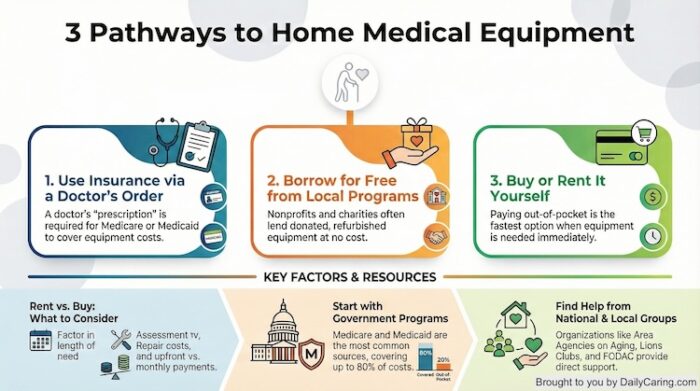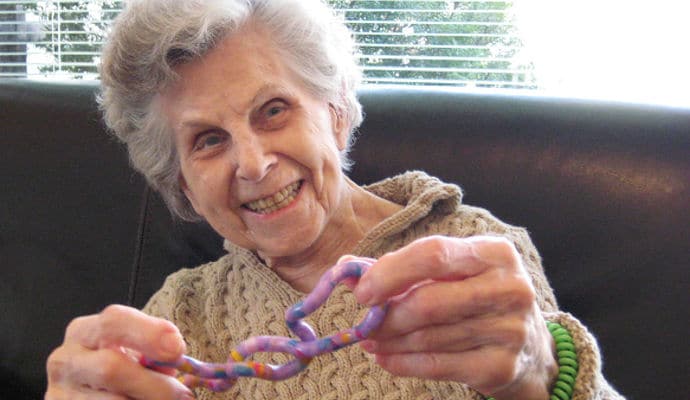Navigating the world of home medical equipment can feel like trying to solve a puzzle with missing pieces. Between confusing insurance requirements, overwhelming product choices, and daunting costs, securing a simple wheelchair or hospital bed can become a significant source of stress.
You know your loved one needs it to be safe and comfortable at home, but the “how” can seem like an insurmountable barrier. The good news is that you don’t have to figure it out alone. By understanding a few key strategies, you can confidently cut through the complexity and access the essential equipment your family deserves.

What Types of Home Medical Equipment are Available for Older Adults?
Many older adults rely on home medical equipment, including walkers, wheelchairs, hospital beds, oxygen concentrators, and other assistive devices, to live as safely and comfortably as possible. But finding the right equipment at the right price can be challenging. Vive Health shares three ways to obtain durable medical equipment your older adult needs.
When it comes to home medical equipment and supplies for an aging adult, there are several ways to find what they need.
Getting medical supplies can be fast and efficient, such as when receiving oxygen, IV, or NG tube supplies. They often arrive via overnight shipping to your door.
For items like a wheelchair, hospital bed, bedside commode, or other durable medical equipment, you may end up waiting weeks or even months.
It will depend on the local medical equipment companies that Medicare requires you to work with for the item to be covered.
But that’s not the only way to find medical equipment and supplies.
Find out about three ways to get the home medical equipment that your older adult needs, with pricing ranging from fully covered by insurance to paying out of pocket.
VIDEO: How to Acquire Home Medical Equipment for Seniors
3 Ways to Get Home Medical Equipment for Aging Adults
1. Get a doctor’s order
If an older adult needs durable medical equipment and wants Medicare Part B or Medicaid to cover it, they’ll need a doctor’s order.
Basically, your older adult’s primary care physician or specialist needs to examine them and write a “prescription” (aka doctor’s order) for the needed equipment. The doctor will also need to complete and submit any other required paperwork.
For example, to qualify for a Medicare-covered wheelchair, your older adult’s doctor may have to assess and determine that your older adult:
- Has difficulty getting around the home, even with a cane or walker
- Is unable to perform daily tasks (like dressing, bathing) on their own
- Has a condition, disease, or injury that requires a specific type of wheelchair in the home
- Can manually operate the wheelchair themselves or have a caregiver who can help at all times
The ability to obtain a doctor’s order also covers other condition-specific durable medical equipment, such as a hospital bed, CPAP machine, patient lift, walker, cane, oxygen concentrator, blood sugar monitor, and more.
Medicare covers the cost of some equipment in full and partially for others. Find out which kinds of durable medical equipment are covered by Medicare Part B here.
If only part of the cost is covered, your older adult would need to make monthly co-payments, either in a rent-based or lease-to-own model—meaning they’d pay a set amount over 12 months and then officially own the equipment.
2. Find a local lending program
Some local nonprofit organizations may offer programs that allow people to borrow medical equipment and assistive devices at no cost.
These programs typically rely on donations of medical equipment from people who no longer need it. The items are cleaned and repaired, then lent to people in need.
Check with the county’s Area Agency on Aging, local senior resource centers, or religious organizations to see if they have medical equipment lending programs.
You’ll often find a range of durable medical equipment, including bedside commodes, wheelchairs, walkers, overbed tables, canes, and sometimes even hospital beds.
Depending on the organization, they may also stock other supplies, such as nutritional drinks, adult incontinence supplies, and cleaning supplies.
3. Buy it yourself (pay out of pocket)
In some situations, time is the most critical factor. Your older adult may need specific medical equipment items immediately.
If that’s the case, you might want to shop around and pay out of pocket.
It is possible to find quality equipment at a reasonable price – you don’t necessarily need to spend an arm and a leg. We’ve got suggestions on where to look.
For example, if you decide to shop online for a high quality cane, you might want to start with a Google search or a search on Amazon.
Stores like Amazon are known for fast shipping and excellent customer service, but don’t always have the lowest prices.
It’s also worth considering other online medical equipment companies that may offer free shipping or special promotions, such as discounts for first-time customers.
If you’d prefer to see and test the item in person, check local drugstore chains (such as CVS or Walgreens) or a major retailer (such as Walmart) to review their selection of medical equipment. You might even be able to use a loyalty card or rewards points to get a discount.
And don’t forget about charity resale shops like Goodwill or Salvation Army – you never know what they may have for sale.
If your older adult is currently using a home health care agency, you may also want to check with them.
Their nurses or aides may be able to bring certain medical supplies at no charge or share advice about which types of durable medical equipment or supplies could help in your older adult’s care.
INFOGRAPHIC: 3 Pathways to Acquiring Home Medical Equipment for Aging Adults

Final Thoughts on Home Medical Equipment for Aging Adults
Securing the right medical equipment is more than just a logistical task—it’s a direct investment in your loved one’s safety, independence, and your own peace of mind. Remember, you are not simply a customer; you are an advocate.
By leveraging insurance, exploring alternative funding sources, and knowing where to find expert guidance, you are building a safer, more supportive home environment. Don’t let the initial hurdles deter you. Use these three pathways as your starting point. The comfort and dignity you help provide make every step of this process worthwhile.
Recommended for you:
- Buying Medical Equipment? Ask 4 Key Questions
- Finding Used Medical Equipment
- What Does Medicare Cover? Find Out Before the Bills Arrive
Guest contributor: Jessica Hegg is the content manager at ViveHealth.com. Interested in all things related to a healthy lifestyle, she shares valuable information to help others overcome obstacles and improve their quality of life.
This article contains some affiliate links. We never link to products or services for the sole purpose of making a commission. For more information, see How We Make Money.
About the Author
Jessica Hegg is a manager at ViveHealth.com. Ms. Hegg was also a full-time caregiver for her Mom who had Primary Progressive MS and Epilepsy. She is a freelance writer with a passion for cooking and lives in Austin, TX with her Mom and her wonderful husband. You can find her personal blog about caregiving tips, ideas, and solutions at Givea.Care.












